|
Raspberries probably suffer greater infection and more serious
damage from virus diseases than any other fruit crop in the
United States. Fruit yields may be reduced 50 to 70 percent,
or more. Once infected, a plant remains diseased for life.
Since all parts of an infected plant carries the virus, suckers
or tips propagated from it are also diseased. All raspberry
viruses in the Midwest, except black raspberry streak, are
spread by the feeding activities of aphids. The viruses are
not spread by pruning or otherwise mechanically injuring
plants in the field.
Virus-like disorders of raspberries and blackberries may
be produced by cool weather and late spring frosts, powdery
mildew, mineral-element deficiencies (such as iron), pesticide
injury, genetic disorders (yellowing of leaves and crumbly
berries), or feeding by leafhoppers, aphids, and red spider
mites.
Positive identification of the virus or viruses responsible
for the disease syndrome cannot be based entirely on foliage
symptoms. Greenhouse and laboratory tests using specific indicator
plants and serology are required. Positive identification
is necessary to facilitate appropriate control measures and
to help detect possible new virus diseases of brambles in
Illinois.
|
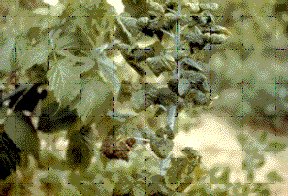
Figure
1.
Leaf curl of red raspberry.
|
RASPBERRY LEAF CURL
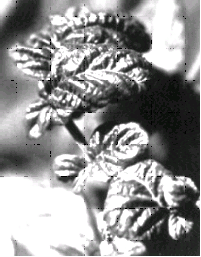
Figure
2.
Leaf curl on black raspberry. The tip leaves are round and
a dark greasy green.
|
This important and easily recognized disease occurs on red,
black, and purple raspberries and upright blackberries. The
yield of infected red raspberries may be reduced 20 to 70
percent. Black raspberries may degenerate and die after two
or three years.
Symptoms on Red and Yellow Raspberries. The
symptoms of leaf curl vary according to the virus strain and
the type of raspberry infected. During the initial year of
infection, plants show no symptoms or perhaps only a mild
down-curling of the leaf tips. The following spring, leaflets
near the tips of the canes appear rounded, dwarfed, and crinkled
with margins curled tightly downward and inward (Figure 1).
Fruiting lateral are shortened and a proliferation of the
shoots may produce a rosette. When diseased shoots first appear
they are a pale yellowish green, soon turning dark green,
becoming stiff and brittle, and usually do not branch. Each
year the plant loses vigor, and new shoots are progressively
more dwarfed until they are only a few inches tall. Infected
plants produce little fruit and berries that do form are small,
dry, seedy, and crumbly.
Symptoms on Black and Purple Raspberries. The
symptoms are similar to those on red and yellow raspberries
with tip leaves arched upward, stiff, dwarfed, and nearly
round, becoming a dark, greasy green (Figure 2). Affected
plants are dwarfed and bushy. The berries are small and dry.
In following years, the young canes are severely dwarfed,
rigid, brittle, lack side branches, and cannot bend to the
ground to root at the tips.
Symptoms on Erect Blackberries. Leaf curl is
rare and unimportant on blackberries. Some cultivars show
curl symptoms similar to those on red and yellow raspberries
(Figure 1). Other cultivars may be infected symptomless carriers
of the virus.
|
Disease Cycle
Leaf curl viruses are commonly spread from plant to plant by the
feeding of a small sluggish aphid (Aphis rubicola). Heavy
populations of this aphid on young foliage can cause severe in-rolling
of the leaves in the absence of the leaf curl virus(es). Winged
forms of the aphid transmit the virus to healthy raspberries from
nearby infected cultivated or wild brambles. Windborne aphids may
spread the virus several miles. All commercial cultivars are susceptible.
Back to Top
COMMON RASPBERRY MOSAIC
|
The common raspberry mosaic complex is widespread and may
cause the greatest reduction in growth, vigor, fruit yield,
and quality of any of the bramble viruses. Fruit yield may
be reduced 50 percent or more. No raspberries are immune,
however, black and purple raspberries are damaged more severely
than red varieties. The symptoms differ with the cultivar
grown, the virus or viruses involved, geographical location,
and seasonal growing conditions. Symptoms are most
evident in the cooler weather of spring and fall, being masked
(or disappearing) when temperatures are high in summer. Mosaic
symptoms are sometimes confused with a late spring frost,
powdery mildew, feeding by red spider mites and aphids, pesticide
injury, or a soil deficiency of boron.
Symptoms on Red Raspberry. The canes are short,
growth is weak, and leaves produced in cool weather are mottled
and puckered with large, irregular, green blisters that arch
upward. The leaf tissue around the blisters turns yellowish
or yellowish green and severely blistered leaves curl downward
(Figure 3). The leaves that develop in hot weather are symptomless,
or show a faint mosaic pattern with yellow flecks. Leaves
that form in late summer show a fine, yellowish, speckled
mottling. Mosaic-affected plants are often progressively more
stunted each year. The leaves are dwarfed, yellow mottled,
sometimes deformed and fruit yield from such plants is reduced;
the berries are dry and seedy (often crumbly) and lack flavor.
|

Figure
3.
Mosaic symptoms on red raspberry in the late spring, green
and yellowish-green ottling appear along with blisters on
a leaf of a new cane (USDA photo).
|
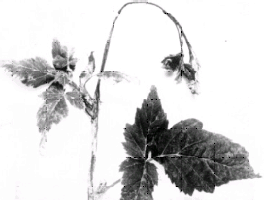
Figure
4.
Young black raspberry cane affected with heat-labile component
of raspberry mosaic.
|
Symptoms on Black and Purple Raspberries. The
tips of young, black and purple raspberry canes, newly infected
with mosaic, often curl downward, turn black (necrotic), and
die (Figure 4). The fruit tends to be small, dry, and seedy.
Leaves produced in hot weather are often nearly symptomless.
Those formed in cool weather are faintly to severely mottled
and puckered. Chronically infected plants become severely
dwarfed and rosetted, with brittle cane tips and usually die
in two or three years.
Symptoms on Erect Blackberries. Infection on
cultivated or wild blackberries is uncommon. They may be symptomless
or show severe mottling, similar to that described for raspberries.
|
Back to Top
THE VIRUSES
The raspberry mosaic virus complex is composed of at least two
viruses, each containing numerous strains. One group survives three
months or longer in infected plants at 100 F (37 C), the other does
not. The heat stable group is called the rubus yellow-net (RYN)
virus because of the distinctive netlike yellowing that develops
along the veins of leaves on infected plants. The heat-labile virus
(which can be eliminated experimentally by growing plants at 100
F or 37 C for a week or more) is named the black raspberry necrosis
(BRN) virus because it causes a dieback (necrosis of the terminal
leaves and cane tips of black raspberry seedlings followed by a
mottling of the lower leaves). Common raspberry mosaic is usually
caused by a virus complex composed of the RYN and the BRN viruses.
Many of the BRN virus strains produce no external symptoms of mosaic
or only an obscure leaf mottling, especially in red raspberries.
Infected plants are weaker, produce fewer canes, and have a reduced
yield. Since these plants appear to be healthy in all other respects,
they are seldom removed from the planting. In addition, numerous
virus strains that are symptomless in red raspberries produce striking
symptoms (stunted mottled leaves on dwarfed shots) when transferred
to black or purple raspberries. The viruses are not soilborne nor
seed transmitted.
Disease Cycle
The large, European raspberry aphid (Amophorophora idaei),
which is widely distributed on the tips of wild and older cultivated
raspberries and some blackberries throughout much of the growing
season, is the most common carrier (vector) of raspberry mosaic
viruses. These aphids acquire ("pick up") the mosaic viruses
after feeding on an infected plant. Winged aphids may transmit the
mosaic viruses from the source plant to a healthy plant a quarter
of a mile or more away. Aphids transmit the viruses by feeding on
healthy plants for a few minutes. Where black and purple raspberries
are grown near aphid-infested red raspberries or other brambles
that have mosaic, the aphids will colonize the black and purple
raspberries and quickly inoculate them with the mosaic virus(es).
Mosaic spreads naturally by commercial propagation from infected
plants and by movement of diseased nursery plants. It may also spread
along a field row through the establishment of suckers or rooting
tips from an infected plant.
Back to Top
BLACK RASPBERRY STREAK
|
This is presently a minor disease that is limited mostly
to the Lake Erie fruit gelt in northern Ohio, western Pennsylvania,
and western New York. Black raspberries, and possibly blackberries,
are the only known hosts.
Symptoms
Numerous (often faint), blue-to-purplish or gray dots and
narrow, water-soaked lines or streaks (usually less than an
inch long) develop on and under the surface on the lower parts
of young canes in warm weather, and sometimes, on fruiting
canes at fruiting time (Figure 5). Infected plants do not
always show streaks, especially if they are not growing vigorously.
Diseased plants, however, are usually vigorous and propagate
well. The severity of the symptoms may vary from season to
season among cultivars, even on the same plant. Infected plants
do not always show streaks, and in fact symptoms may vary
from season to season among cultivars.
Tip leaflets on infected new canes are often hooked or recurved,
spirally twisted or rolled, and a darker green than normal
(Figure 6). Sometimes the lower leaves on such canes show
yellowing along the veins (vein-clearing ) or mottling. Leaf
symptoms are more consistent than cane streaks in field plantings.
Fruits on infected plants are about three-quarters of the
normal size, dull, seedy, crumbly, and lacking in flavor.
The individual drupelets often ripen unevenly, giving the
fruit a blotched appearance.
|
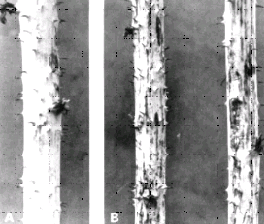
Figure
5.
Black raspberry streak; A. normal cane; B; canes showing
severe streak symptoms..
|
Back to Top
Disease Cycle
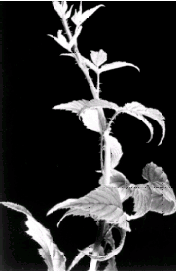
Figure
6.
Black raspberry cane 'hooking' and recurving of leaves caused
by streak virus.
|
How black raspberry streak spreads in nature is
not known. Insect vectors whose identity is unknown may play
an important role. The virus is not soilborne, and is
not transmitted by the common raspberry aphids and other
insects that frequently colonize brambles. There is good evidence
that the virus does spread in the field. Healthy plants within
10 feet of an infected plant are three times more likely to
become infected than are more distant plants. The number of
visibly infected plants in a fruit planting may double each
year because of the difficulty of detecting black raspberry
streak, it is easily carried along with rooted tips in nursery
propagation. |
Back to Top
RED RASPBERRY RINGSPOT
Laminated evidence suggests that red raspberry ringspot, caused
by the tomato ringspot virus (TomRSV), is the most widespread and
damaging virus disease of red raspberry in North America, yet it
was not identified until 1962. However, "running out"
or "decline" of raspberry plantings, characterized by
the gradual loss of productivity, has been known for many years.
Symptoms
The symptoms in red raspberries vary depending to a large extent
on the cultivar, the duration of the infection, and the time of
year when plants are examined. Infected plants, which normally occur
in patches, usually show no symptoms during the season in which
they acquire the virus. In the spring of the following year, some
leaves on the primocanes develop yellow rings, line patterns, or
vein yellowing. These "shock reaction" symptoms are rare
in subsequent years. Chronic symptoms are delayed foliation in the
spring, a tendency for leaves on the fruiting canes to develop various
degrees of chlorosis, and for diseased plants to produce a higher
proportion of misformed or crumbly fruit than do healthy plants.
These symptoms are all variable, unreliable, and can be missed in
disease surveys based on field observations. Field surveys are of
little value unless visual observations are supplemented by (1)
mechanical inoculations to herbaceous indicator hosts, or (2) highly
specific serological tests such as ELISA.
It is not unusual when examining plants in fields with a history
of poor productivity, to have apparently healthy plants index positive
for TomRSV using the ELISA technique.
Back to Top
Disease Cycle
Tomato ringspot virus is spread from plant to plant in the soil
by the feeding of one or more species of dagger (Xiphinema) nematodes
on the roots of red raspberry plants. Field spread is restricted
to plantings where these very common nematodes occur. The nematodes
by themselves cause little damage to red raspberry plants unless
the virus is also present.
Back to Top
RASPBERRY BUSHY DWARF
Raspberry bushy dwarf, caused by the raspberry bushy dwarf virus
(RBDV), infects red and black raspberries and blackberries. Not
all red raspberry cultivars are susceptible to this vigor- and yield-reducing
virus. When a planting becomes uneconomical, the planting can be
replaced with a resistant cultivar. Some cultivars in Europe previously
considered to be immune have become susceptible to few strains of
RBDV. There is no evidence that any of these severe strains occur
in North American cultivars.
Symptoms
The severity of symptoms of raspberry bushy dwarf vary with the
cultivar and the season. Some cultivars produce leaves with varying
degrees of interveinal chlorosis; other leaves develop irregular
line or "oak leaf" patterns. Plants that show symptoms
one year do not necessarily develop symptoms in subsequent years.
Variations in leaf symptoms are believed to be dependent on genetic
resistance to symptom expression and on environmental factors.
Back to Top
Disease Cycle
Raspberry bushy dwarf virus is transmitted through pollen from
which infection spreads to a high proportion of the seeds and to
the pollinated plant. The virus is confined to species of brambles
(Rubus) and natural spread only occurs through pollen or seeds.
Back to Top
Control of Virus Diseases
The cultural and chemical practices outlined below, if vigorously
followed, will keep virus diseases in check. Remember: once infected,
a plant remains diseased, it cannot be cured.
1. Select a planting site that is sunny and fertile and has good
air and soil drainage. Where possible destroy all wild and neglected
raspberries, blackberries, wineberries, and other brambles located
within 600 to 1,000 feet. These plants are likely to harbor viruses,
other bramble diseases or disorders, and insects.
2. If both black and red raspberries are to be grown, separate
them by 150 feet or more to reduce virus cross infection. If possible,
plant the blacks on the windward side which further decreases virus
spread by windborne aphids.
3. Start new plantings with the best quality plants available.
Avoid the illegal, neighborhood exchange of noninspected plants
(many plants are protected by patents). The U.S. Department of Agriculture
has developed virus indexed stocks of many desirable red, black,
and purple raspberries, and blackberries that are true to cultivar
and genetically equivalent to the best available stock. These are
propagated under rigidly controlled conditions by growers in well
designed programs certified by state authorities. Virus indexed
plants sell at a premium, but are well worth the extra expense.
Certification schemes that involve only visual examination with
approval based on the absence of symptoms, are next to worthless.
Several of the raspberry and blackberry viruses induce either no
symptoms or symptoms that are so vague and variable as to be unreliable
indicators. Sap inoculation, graft inoculation, serology (e.g.,
ELISA), elegron microscopy, or combinations of these techniques
are required to detect infections. Extensive indexing of an individual
plant and then subdividing this plant to establish a certification
block of "mother" plants is preferable to establishing
a certification block from several mother plants.
4. After growth has begun, go through the planting several times
each season and remove all visibly infected plants. The best time
to detect virus symptoms is during cool, cloudy weather in the mid
to late spring, early summer, and again in the early to mid fall.
A day or two before removal, thoroughly spray affected plants
with malathion (25 percent wettable powdery), using 2 tablespoons
per gallon of water, or scorch the diseased plants with a weed burner.
These treatments will kill any virus carrying aphids and prevent
their migration to healthy plants. All plants showing even faint
symptoms of leaf curl, mosaic, black raspberry streak, or other
diseases should be removed. Bush removal or roguing is most effective
during the first year, since this decreases the source of the virus(es)
for the following season and also saves the work of digging out
a much larger plant with an extensive, virus-infected root system.
Removing or marking black raspberry plants that leaf out later than
normal in the spring is advisable, as they are very likely to have
mosaic. In established plantings, where more than 5 to 10 percent
of the plants are visibly virus-infected, roguing will probably
not pay. Maintain the fruit planting until the yield of fruit becomes
unprofitable, then destroy it.
5. Maintain strict aphid control at all times, especially in late
spring and early summer when aphid populations are likely to be
high. Various insecticides can be used. Follow the cultural and
chemical recommendations outlined by entomologists at the University
of Illinois as given in the "Illinois Commercial Small Fruit
and Grape Spray Guide" (updated annually); (website: http://www.ag.ohio-state.edu/~ohioline/b861/index.html),
and "Compendium of Raspberry and Blackberry Diseases and Insects",
published by the American Phytopathological Society, St. Paul, Minnesota.
The pesticide manufacturer's directions concerning rates and time
should be carefully followed. Because the harvest season and aphid
buildup may coincide, pay careful attention to insecticide residues.
Observe the recommended safe interval between application and harvest.
6. Fumigation of soil with methyl bromide, chloropicrin-methyl
bromide mixtures, Vorlex, or D-D prior to planting to eradicate
nematode (Xiphinema spp) vectors or red raspberry ringspot is necessary
where these nematodes are present. The manufacturer's directions
should be carefully followed when applying these highly toxic pesticides.
Genetic resistance to some bramble viruses and their aphid vectors
is being incorporated in the development of new raspberry and blackberry
cultivars with plant breeding a promising new method of controlling
bramble viruses.
Back to Top
|



